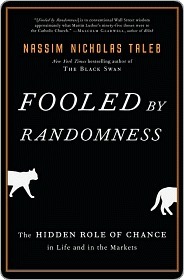More on this book
Community
Kindle Notes & Highlights
Read between
July 27 - July 27, 2021
Common statistical method is based on the steady augmentation of the confidence level, in nonlinear proportion to the number of observations. That is, for an n times increase in the sample size, we increase our knowledge by the square root of n. Suppose I am drawing from an urn containing red and black balls. My confidence level about the relative proportion of red and black balls after 20 drawings is not twice the one I have after 10 drawings; it is merely multiplied by the square root of 2 (that is, 1.41).
Where statistics becomes complicated, and fails us, is when we have distributions that are not symmetric, like the urn above. If there is a very small probability of finding a red ball in an urn dominated by black ones, then our knowledge about the absence of red balls will increase very slowly—more slowly than at the expected square root of n rate. On the other hand, our knowledge of the presence of red balls will dramatically improve once one of them is found. This asymmetry in knowledge is not trivial; it is central in this book—it is a central philosophical problem for such people as Hume
...more
Theories that are known to be wrong, as they were tested and adequately rejected (he calls them falsified). Theories that have not yet been known to be wrong, not falsified yet, but are exposed to be proved wrong.
Unless you have confidence in the ruler’s reliability, if you use a ruler to measure a table you may also be using the table to measure the ruler.


